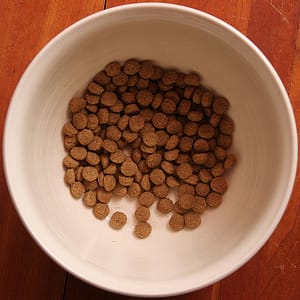How to Transition to Scheduled Feeding From Free Feeding
Stop Free-Feeding: How to Feed Your Dog Regular Meals

Is there always a bowl of food on your kitchen floor? If so, you're free-feeding. (Photo by JnL on Flickr.)
One of the first management recommendations I make to my clients is to stop "free-feeding" their dog. Free-feeding means leaving a bowl of dog food on the ground for hours at a time, if not all day long, rather than giving the dog regularly scheduled meals which need to be eaten immediately.
Here are some of the problems with free-feeding:
Free-fed dogs are harder to housebreak. Scheduled input of food means scheduled output of poop. If you've got a new puppy and you're free-feeding it, you're making house training infinitely harder.
It limits your dog's motivation to eat treats. When I have a new client who complains, "My dog isn't food motivated!", more often than not, they're free-feeding the dog. I tell clients this is like having a bowl full of $1 bills on the table, free for the taking, then telling your child he needs to earn his $5 weekly allowance. Why would he work when he can just grab a fistful of dollars when he wants?
You don't know if your dog's appetite has decreased. This can be a tell-tale sign of illness. When I feed my dogs, they immediately wolf down their food. If I ever put down a bowl of food and one of my dogs didn't eat, that would earn them an immediate trip to the veterinarian. Also, if your dog ever needs emergency surgery, the vet will want to know when your dog last ate. If you're free-feeding, that answer could be 30 minutes ago or 3 hours ago – you have no way of knowing.
It attracts pests. Disgusting but true – we've found ants and mouse poop in and around the food bowls of dogs that are free-fed.
Additionally, almost every free-fed dog I have met is overweight. Rarely, a dog may have a medical condition requiring it to be free-fed. If that's the case, follow your veterinarian's advice when it comes to feeding your dog.
How to Make a Change
If you're ready to stop free-feeding your dog, here's how you do it.
Step 1: Decide how often you are going to feed your dog. For most dogs, twice a day is enough – once in the morning and once at night. Puppies and small-breed dogs may do better being fed three times per day.
Step 2: Decide how much you are going to feed your dog. Some owners actually don't know how much food their dog eats in a given day – they just keep the bowl full, and if it gets low, they dump in some more kibble. Use the amount listed on the dog food bag as a guideline for how much to feed your dog. (In my experience, these amounts tend to over-estimate how much food your dog needs.)
Step 3: Pick up the food bowl and clean it thoroughly. If you've been free-feeding for awhile, chances are it's been awhile since your dog's bowl was washed.
Step 4: At the next scheduled mealtime, measure out your dog's food in the bowl and place it on the ground. Set a kitchen timer or your phone alarm to go off in 15 minutes and let your dog eat. She may not eat anything! Don't worry about it.
Step 5: When that timer goes off, pick up the food bowl. If there's anything left, measure it and subtract that from your first measurement so you know how much food your dog ate. Throw out whatever's left.
Step 6:Do not give your dog any food until the next scheduled feeding. (An occasional training session or small snack is okay, but nothing more!)
Step 7: At your next scheduled mealtime, repeat steps 4 and 5.
Within 48 hours your dog should be eating most if not all the food you give her, and will begin eating as soon as the bowl hits the ground.
Troubleshooting
"My dog isn't finishing her meals!" If your dog consistently does not finish her meals, you are probably offering too much food. Reduce the amount of kibble accordingly.
"My dog eats everything in her bowl and still seems hungry!" Most dogs are always "hungry" – self-control is not their strong suit. If your dog is wolfing down her food and you are feeding the amount suggested on the dog food bag, do not give her more food yet – wait a week or so, see if she's gaining or losing weight, and adjust accordingly.
"My dog isn't interested in the food when I put it down, so I added a little water/broth/chicken/dog treats/cat food…" Stop! Your dog is training you. If she ignores her food, you'll add something exciting to it, therefore she continues to ignore her food until there's a nice snack in it. If you want to give your dog a special snack, use it as a training treat, or add it to the food bowl before you put it on the ground – not after she's decided to ignore her regular kibble.
It's That Simple
This process really is not that difficult. All you need to do is stick to your guns, put down dog food 2-3 times a day, and not add any "goodies" trying to entice your dog to eat. A healthy dog absolutely will not starve herself. If you are concerned about your dog's health, contact your veterinarian before beginning this plan.
Share This Story, Choose Your Platform!
Source: https://crossbonesdog.com/stop-free-feeding-how-to-feed-your-dog-regular-meals/
